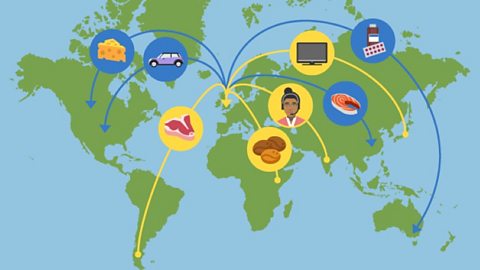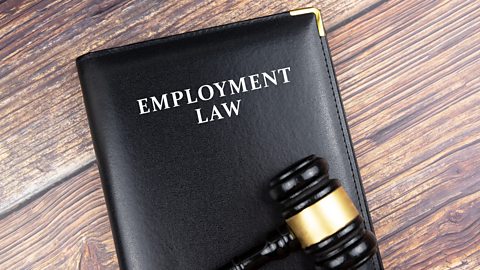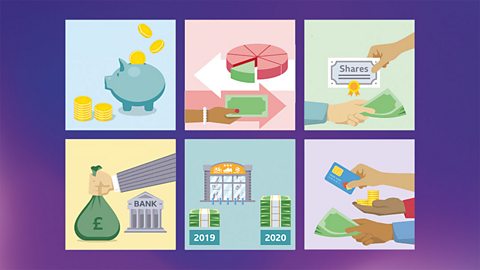Creating a business
Entrepreneurs
Explore and revise key points about Entrepreneurs including Purpose, Opportunities, and Skills.

Business resources
Learn how businesses use the four key resources (factors of production) to create goods and services.

- Guide Number6 Guides

What is the public and private sector?
Public sector services, government-funded education and healthcare, contrasted with private sector businesses that aim for profit and are financed through private investments.

What is the role of social enterprise?
Discover how social enterprises reinvest profits to create jobs, support communities, and protect the environment. Learn how these businesses balance profit with positive impact.

Business location
Choosing business locations: factors like customer proximity, raw materials, government influence, and land prices are crucial in finding the perfect spot.

What are stakeholders?
Who shapes a business's fate? Shareholders, communities, employees, and pressure groups all have stakes, but their goals often clash. How can businesses balance these interests?

What are business aims and objectives?
Businesses thrive by setting clear goals, from survival to success. SMART objectives make goals achievable and measurable. As markets change, business aims must evolve too.

Marketing
- Guide Number8 Guides

- Guide Number5 Guides

What is the competitive environment?
Launching a new business amidst competition? Outshine rivals by lowering prices, offering unique products, or focusing on top-notch quality. What's your next move?

What is the importance of good customer service?
Great customer service can enhance a brand's reputation, while poor service can damage it. Friendly staff and quick problem-solving are key. What do you expect as a customer?

What is international business?
International trade brings growth but involves language barriers, cultural differences, and complex supply chains. Businesses must adapt to thrive globally.

What is E-business and M-business?
Explore e-business and m-business, where the internet and mobile devices expand customer reach. Discover the benefits and challenges of this digital transformation.

Business operations
What types of production are there?
Discover the primary, secondary, and tertiary sectors that shaped the nation. From farming to factories to services, learn what caused these shifts.

What are the methods of manufacturing?
Businesses choose custom-made or mass-produced products based on cost, demand, and technology. Discover how these factors shape the products we use daily.

What is specialisation and the division of labour?
Specialisation and division of labour boost efficiency by focusing on specific tasks, improving skills and productivity. This leads to expertise and higher quality outcomes.

What is stock control?
Businesses balance inventory and costs with methods like just-in-time ordering and large inventories. Timing is key to avoid waste and ensure availability.

What is quality assurance?
Businesses meet customer expectations with quality assurance, earning standards like ISO 9001 and investing in employee development. Quality ensures competitiveness and trust.

Why is health and safety crucial in manufacturing?
Health and safety in manufacturing is crucial. Proper training, equipment, and regulations ensure well-being and productivity. Neglecting safety can lead to accidents.

Human resources
What are recruitment documents?
Businesses recruit to replace staff and support growth. Key documents include person specifications and job descriptions. Contracts outline terms for various roles.

What is internal and external recruitment?
Discover recruitment strategies. Learn the pros and cons of internal and external recruitment also learn how social media is transforming hiring.

What is employment law?
Learn about employment law, fair recruitment, minimum wage, anti-discrimination protections and safe working conditions.

What methods of selection are used in business?
Discover how human resources selects the best candidates. Learn about application forms, CVs, interviews and more in this informative article on selection methods.

What is an appraisal?
Why are staff appraisal so important? This article looks at the pros and cons for employers and employees. Learn about the methods of appraisals.

What is staff training?
Staff training boosts productivity, adapts to changes and enhances competitiveness. There are different types of training, on-the-job is practical; off-the-job is theory based.

- Guide Number2 Guides

Business growth
What is business success or failure?
Learn what the signs are of a successful business and a business failing.

How can a business grow internally or organically?
Learn about different types of internal/organic growth, including: reinvestment, expansion of product range and increased sales activity.

How can a business grow externally or inorganically?
Learn about different types of external growth, including: takeovers, mergers and franchising.

Advantages and disadvantages of business growth
Explore the different aspects of business growth. What can limit growth?

What are the ethical implications of business growth?
Ethical growth involves balancing profit with fairness, transparency and responsibility towards stakeholders and the environment.

Finance
What are sources of finance in business?
What are the sources of finance? Learn about internal finance and external finance.

What is break-even?
Learn to calculate break-even graphically and by formula also learn the significance of the break even-point.

- Guide Number2 Guides

What are ratios?
Looking at an income statement to assess business performance using different ratios including: gross profit %, net profit percentage and working capital ratio.

What is a cash flow forecast?
A cash flow forecast helps businesses predict cash inflows and outflows over the coming months, helping to avoiding cash shortages.

Business plan
What is a business plan?
Learn about the importance of a business plan, detailing its key sections and how it helps entrepreneurs minimise risks, make informed decisions and secure financing.

Links
- External linkExternal link
- External linkExternal link
- External linkExternal link
- External linkExternal link
- SubscriptionSubscription